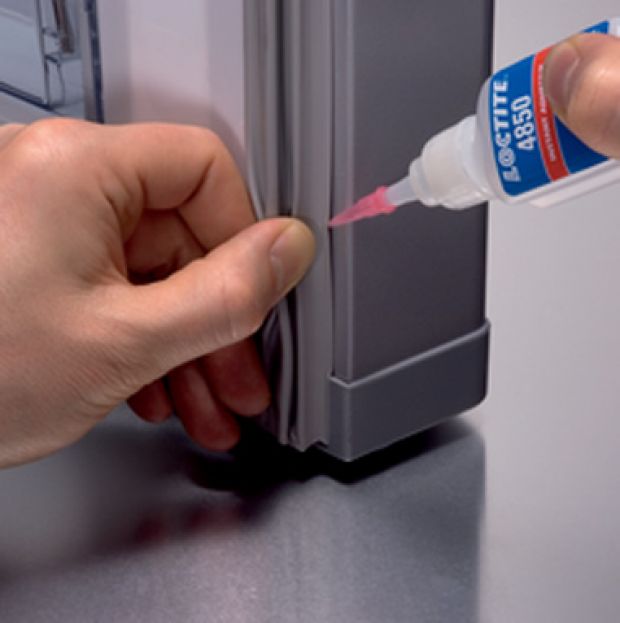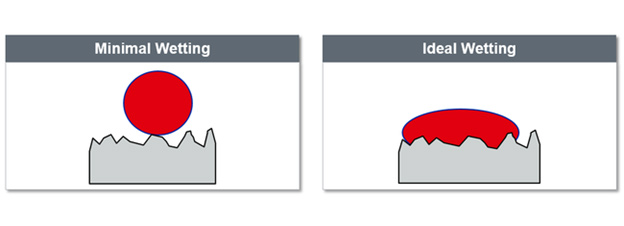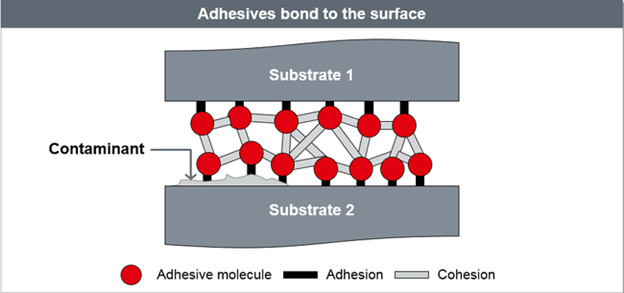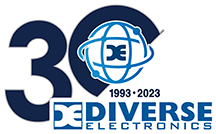Blog
Why Proper Surface Preparation is Important to Ensure a Strong Adhesive Bond

Adhesives can be seriously strong. They’re used in the manufacture of anything from airplanes, automobiles and massive machinery to baby products, golf clubs and mobile phones. These are demanding applications. But if you’re hoping to achieve optimal performance, there’s a job that must be completed before an adhesive is applied: surface preparation.
The Importance of Surface Energy
To ensure a strong bond, the surface you’re applying an adhesive to is equally as important as the adhesive itself. Surface energy is the main measurement that you need to understand. An adhesive’s surface energy needs to be lower than that of the surface you’re applying it to in order for it to work correctly.
Think of water on the hood of a car: a waxed hood has a lower surface energy than water, so the water beads up and rolls off the hood. An unwaxed hood has a higher surface energy, so the water “wets out” on the hood and completely covers it.

With adhesives, “wetting out” creates a strong bond because the adhesive is able to spread across the entire substrate to create a larger contact area.
Three Ways to Increase Surface Energy
If you find that your substrate's surface energy is too low, there are ways to increase it. To start, it should be:
- Clean – If a substrate is dirty, your bond is only as strong as the adhesion of the contaminant to the part, not the adhesive to the part. Contaminants can come from machining, protecting, handling, manufacturing, facility surroundings, and even from cleaners used previously that have left a film. Just a slight oil film left behind on a substrate can reduce adhesive performance by as much as 60 percent.

- Dry – A wet surface poses the same problems as a dirty one. Moisture between an adhesive and a substrate should be treated as a contaminant and removed to ensure a strong bond.
- Rough – A surface is best when made rough. A light grit blast or sanding will increase the bond area where the adhesive interacts with the substrate because a surface with peaks and valleys has more surface area than a completely flat surface. The roughness will also provide a slight mechanical grip for the adhesive to hold onto.
Using Primers
Once the part is clean, dry and rough, it might still have a low surface energy. Some materials are just notoriously hard to bond. When that’s the case, primers can increase the surface energy of substrates so adhesives bond more effectively.
As with choosing a cleaner, it’s best to consult with your supplier or local sales representative to discuss the proper product selection. In addition, you can contact our team directly.
Alternate Surface Preparation Methods
When chemically priming a surface isn’t an option, there are alternate surface preparation methods ranging from flame treatment to surface roughening to chemical etching. What you choose will depend on substrate materials, adhesive types and surface conditions.
That said, in most scenarios, a clean, dry and rough surface is generally all you need for a strong bond.
Resources for Working with Different Materials
For more information on surface preparation, you can check out the following resources:
- Design Guide for Bonding Metals
- Design Guide for Bonding Rubber and Thermoplastic Elastomers
- Design Guide for Bonding Plastics
- Adhesive Sourcebook
For further information or to speak to a representative, click on the following link.
Courtesy: Henkel Adhesives, Industrial Manufacturing and Engineering Blog
Author: Michael Pomykala, Application Engineer for Henkel North America
Surface Energy, Surface preperation, Adhesives, Loctite
Categories
- Aimtec
- Alternative Energy
- APEM
- Automotive AEC-Q200
- Brady Canada Labels & Printers
- BUD Industries
- Diodes
- Displays
- Diverse Electronics
- EMI/RFI Shielding
- ESD Diodes
- ESD-Static Control
- Industrial Vending Program
- Inspection Cameras
- Loctite Adhesives
- OC White Magnifiers
- Power Supplies
- SCS Static Control
- Stannol Solder
- SunLED LEDs
- Test Instruments
- Thermal Imaging
- Wago Connectors
- Winstar Displays
- Yageo

